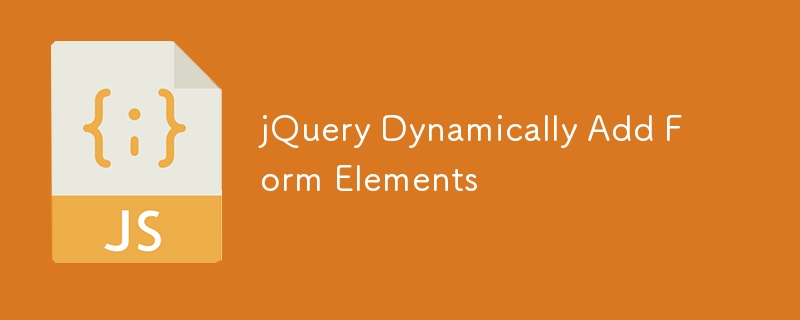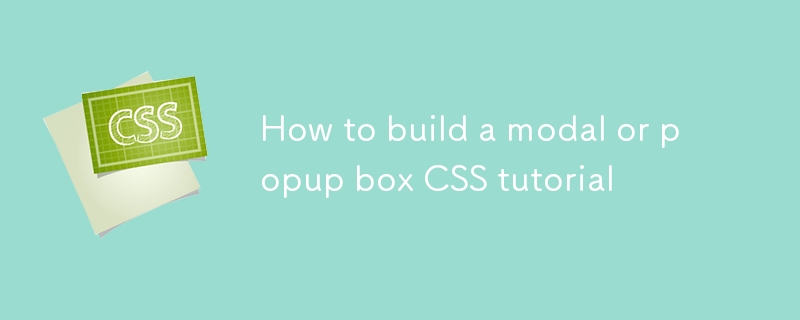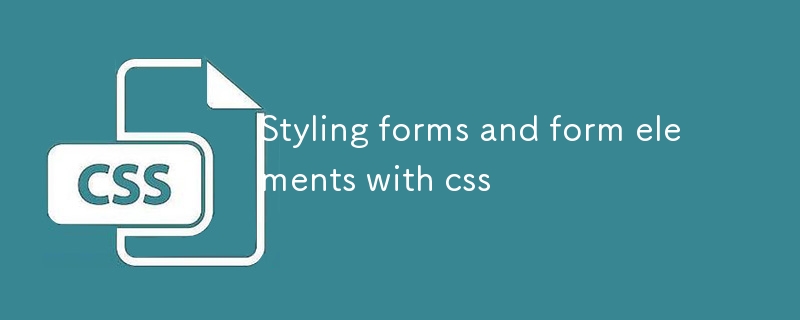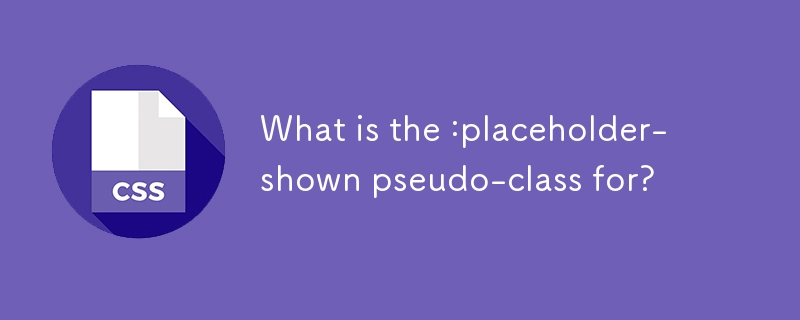Found a total of 10000 related content

jQuery Dynamically Add Form Elements
Article Introduction:Use jQuery/JavaScript to dynamically add form elements. This is useful when the DOM is already loaded and you need to add additional input fields based on user action or selection (for example). You can create any new form element, not just input fields. Alternatively, you can create input elements in the page and simply hide them and display them again if needed.
Example: When changing password1, insert a new input box named password2 after it is called password1.
// Listen to the change event of the password1 field to prompt for adding a new input box
$('#pas
2025-03-04
comment 0
427

What is the placeholder attribute in form inputs?
Article Introduction:The Placeholder property should display prompt information when the input box is empty when it is used for form input. Its main purpose is to improve the user experience through examples. First, display format examples in the input box, such as the phone number input box can display "(123)456-7890", and the user name input box can prompt "at least 6 characters"; second, it cannot replace the tag and verification function, and needs to be used with the tag to ensure accessibility; third, it is compatible with modern browsers. Old browsers such as IE9 and earlier versions do not support it, and can be processed through JavaScript fallback scheme; fourth, styles can be adjusted through CSS specific syntax, such as setting color and font style.
2025-06-22
comment 0
814

How can the inputmode in html attributes improve the user experience on mobile devices?
Article Introduction:inputmode is an attribute in HTML that is used to optimize the mobile input experience. It reduces user input steps by prompting the browser to display a specific virtual keyboard type. For example, setting the phone number input box to inputmode="numeric" can directly call out the numeric keyboard to avoid switching. Common applicable scenarios include: 1. Set the phone number input box to numeric; 2. Use numeric in the amount or zip code field; 3. Search or default can be used in the search box or address bar; Password field is usually not recommended. Commonly used values ??include text, none, decimal, numeric, tel, email and url, etc., and should be flexibly selected according to actual needs.
2025-06-27
comment 0
945

How to do bootstrap modal box
Article Introduction:How to create modal boxes using Bootstrap? Create a modal box with the appropriate HTML structure. Includes Bootstrap and jQuery libraries to enable modal functionality. Use JavaScript or jQuery code to display or hide modal boxes.
2025-04-07
comment 0
1053

How do I use the placeholder attribute to provide a hint to the user about what to enter in the input field?
Article Introduction:The placeholder property is used to display prompt text when the input box is empty, but it cannot replace label or form verification. Correct usage includes: 1. It must be used with label to improve accessibility; 2. Do not use placeholder to replace the required prompts, and should be combined with the required attribute; 3. Avoid placing too much explanation information in placeholder; 4. Set appropriate example text according to different input types, such as text, email, password and other input boxes.
2025-06-28
comment 0
503

What are the different types of input fields (text, password, email, number, date, checkbox, radio, file, submit, reset)?
Article Introduction:Common input fields for web forms include text, password, email, number, date, radio boxes, check boxes, file upload, submit buttons and reset buttons. 1. Text input (text) is used to freely enter text content, requiring additional verification; 2. Password input (password) hides user input and is often used with confirmation of passwords; 3. Email input (email) automatically checks the format, mobile adaptation optimization; 4. Number input (number) limits input to numbers and supports setting range and step size; 5. Date selection (date) provides calendar controls to improve experience, but compatibility needs to be considered; 6. Radio box (radio) is used for multi-option radio, and the name attribute must be consistent; 7. Checkbox (checkbox) is used for multiple
2025-06-26
comment 0
894

How do I use the value attribute to specify the initial value of an input field?
Article Introduction:In HTML, the most straightforward way to set an initial value for a field is to use the value attribute. 1. The basic usage is to specify the default display of the input box through value, which is suitable for text, password, email, number and other types, such as; 2. It can be used for password boxes and number boxes, such as and; 3. Dynamically generate HTML in form backfill combined with PHP or JavaScript to retain the content that the user has filled in, such as
2025-06-24
comment 0
1010

How do I use the type attribute to specify the type of input field?
Article Introduction:The type attribute in the HTML form is used to specify the input type, which affects the performance and function of the input box. Common types include: 1.text is used for text input; 2.password is used to hide passwords; 3.email is used to verify mailbox format; 4.number is used to limit digital input; 5.date provides date selector; 6.checkbox and radio implement multiple or single-select; 7.submit creates submission button. When using it, you can directly add type attributes to the input tag and set corresponding values. You can combine placeholder, min, max, required and other attributes to enhance the interactive experience. At the same time, pay attention to selecting according to the device optimization type to improve usability.
2025-06-30
comment 0
631

How to build a modal or popup box CSS tutorial
Article Introduction:To create a basic modal box or pop-up box, first build the structure using HTML, then style it through CSS, and optionally implement interaction using JavaScript. 1. The HTML part includes trigger buttons, modal box containers and contents; 2. CSS is used to set positioning, overlaying and centering effects; 3. JavaScript controls display and hide; 4. Responsive design recommends using percentage width and media query to adapt to different devices. The whole process is simple and effective and is suitable for most simple scenarios.
2025-07-13
comment 0
720

What are the different input types in an HTML form
Article Introduction:There are 8 common input types in HTML forms, which are suitable for different data input requirements. 1.text is used for basic text input; 2.password is used to hide the password input displayed; 3.email is used to input email addresses specifically; 4.number is used for digital input and supports adjustment of numerical values; 5.checkbox is used for multiple selection check boxes; 6.radio is used for single-select button groups; 7.date provides date selection function; 8.submit is used to submit form data. Each type has its own specific uses and browser support features. Regular use can improve user experience and data processing efficiency.
2025-07-07
comment 0
938

How to validate a form with js?
Article Introduction:The key to form verification is to clarify the rules, reasonably bind events, and friendly prompt users. 1. Determine the fields to be verified, such as required items, format verification (email, phone number), and length limit (such as at least 8 digits of password); 2. Listen to the submit event through addEventListener and get the input value, and use e.preventDefault() to prevent the default submission; 3. Display error prompts. It is recommended to use elements to display specific information and clear the prompts when the input box gets focus; 4. You can combine HTML5 built-in verification attributes such as required, type="email", and minlength to improve compatibility, but it is still recommended to customize the prompts to maintain consistency.
2025-06-29
comment 0
366

Exploring Different Input Types for HTML Forms
Article Introduction:The input type improves form experience and verification efficiency. HTML5 provides various input types such as text, password, email, etc., which are adapted to different scenarios such as username, password hiding, and email verification; supports number limited number input, date selection, checkbox multiple selection, radio single selection, file upload, range slider bar, color color selection; combines required, min/max, and pattern to achieve front-end verification to reduce the burden on the back-end; mobile terminals automatically adapt to keyboard types such as email display @ symbols, tel calls numeric keyboards; provide input-able option list, readonly lock fields, hidden through datalist
2025-07-06
comment 0
569

Styling forms and form elements with css
Article Introduction:To make the form more beautiful and improve the user experience, you can optimize it from the following four points: 1. Unify the basic style of the input box and add: focus effect; 2. Hide native check boxes and radio buttons and replace them with custom icons; 3. Set hover, active status and animation for the submission button; 4. Keep the form layout neatly and aligned, and use .form-group to uniform spacing.
2025-07-10
comment 0
561

Bootstrap 5 navbar example with search bar
Article Introduction:The method of adding a search box to the navigation bar of Bootstrap5 is as follows: 1. Insert the input element with the form-control class in the navbar and place it in a suitable container; 2. If the mobile terminal needs to always display the search box, you can move it outside collapse or set the style separately; 3. You can optimize the appearance of the search box through form-control-sm, button style adjustment and alignment classes. The implementation is clear and responsive, and is suitable for beginners.
2025-07-17
comment 0
753

What is the :placeholder-shown pseudo-class for?
Article Introduction:The :placeholder-shown pseudo-class is used to style the input box when the placeholder text is visible, and it takes effect when the user does not enter content. 1. It is suitable for form scenes that require visual feedback, such as distinguishing empty fields from filled fields; 2. It can be used to adjust borders, background colors or control other elements to display and hide; 3. It acts on elements with placeholder attributes; 4. Common uses include highlighting required items, changing border colors or adding transition animations; 5. Pay attention to its incompatibility and its differences from ::placeholder, which is used to directly style the placeholder text.
2025-07-11
comment 0
904

How do you use the input type='date' and other date/time inputs?
Article Introduction:HTML provides built-in date and time input types such as type="date" and type="time" to simplify user input. 1. Basically, using type="date" will display a text box with a calendar icon. After clicking, open the date selector, return the value in the format YYYY-MM-DD, and can pre-fille and limit the date through the value, min and max attributes; 2. Other related types include type="time" (select hours and minutes), type="datetime-local" (select date and time, not including
2025-06-26
comment 0
163

How can CSS be used to style form elements consistently across different browsers?
Article Introduction:To keep a form element consistent in style across different browsers, you must first reset the default browser style. The steps include: 1. Use CSS to reset or normalize.css to clear the default style; 2. Clearly set border, padding, margin, font-family and appearance attributes; 3. Customize the appearance of the input box after removing the native style; 4. Use pseudo-elements and hide the original input box to implement custom check boxes; 5. Make limited style modifications to the select element or use JavaScript to build a custom drop-down menu. These methods can achieve cross-browser consistency, but some complex elements such as select may require additional tool assistance.
2025-06-12
comment 0
1009

Setting Default Values for Form Inputs with the HTML value Attribute
Article Introduction:The most direct way to set the default value of the form input box is to use the HTML value attribute. The value attribute is used to specify the initial value of the form element, such as:. Common elements that support this attribute include text input boxes, password boxes, radio buttons, check boxes (need to be selected by default with checked settings), submit buttons, etc. Correct usage methods include setting strings for text input, setting legal values for numeric input, and transmitting hidden fields. Notes include: avoid unescaped special characters and elements with selected instead of value, and default values should be written in the tag content. Rational use of value can improve user experience and reduce input burden.
2025-07-13
comment 0
444

Providing suggestions for form inputs with the HTML5 `` element.
Article Introduction:Using HTML5 elements can effectively improve the form input experience. 1. The basic usage is to bind the same through the list attribute, for example, setting the list value of the input box is the same as the datalist id; 2. It not only supports text input, but also applies to types such as numbers, colors, etc., but some types such as colors may not display a suggestion list in the browser; 3. You can dynamically fill options through JavaScript to load data from arrays or interfaces, and combine input events to achieve real-time search suggestions; 4. In terms of style, it mainly controls the appearance of the input box, the style of the drop-down list is limited, and you need to pay attention to the compatibility issues between the mobile and old browsers, and the server still needs to verify and fault tolerance.
2025-07-09
comment 0
221


















